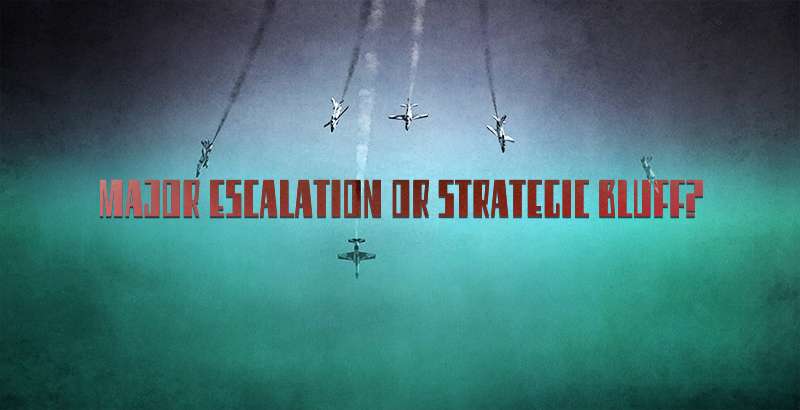
It’s clear that the recently adopted ceasefire threatens the Turkish and Saudi interests in Syria significantly. Both countries support a wide range of Islamic militant groups including Al Nusra Front, which was designated as a terrorist organization by the UNSC. Turkey has clearly been violating Syria’s sovereignty with its systematic artillery shelling of the northern part of the country and by allowing the flow of reinforcements to militants while Saudi Arabia spent significant amounts of petro-dollars in order to support groups attempting to overthrow the Syrian government. In this case, the Turkish statements claiming the possibility of a military invasion of Syria and Saudi Arabia’s intention to deploy an air force to support the Turkish operations can’t be ignored.
Written and produced by SF Team: Brian Kalman, Edwin Watson
Brian Kalman is a management professional in the marine transportation industry. He was an officer in the US Navy for eleven years. He currently resides and works in the Caribbean.

The Syrian conflict took a decidedly sinister turn for the worse recently, with the announcement of Saudi Royal officials that the kingdom intended to commit both air and ground forces to fight against Daesh (ISIS) in Syria. The word hypocrisy immediately comes to mind with such a statement, in light of the reality that ISIS and similar Islamic fundamentalist groups wreaking havoc across Syria have been armed and funded by Riyadh from the start. All of these groups have a shared ideology and embrace the Wahhabi school of fundamentalist Islam, which was founded and fostered by Saudi Arabia. Wahhabism has spread like a scourge across the Middle East, and beyond, because of the patronage of the Saudi monarchy.
On Saturday, February 14th, Saudi Brigadier General Ahmed al-Assiri confirmed that Saudi Royal Air Force jets were deployed to Incirlik air base in southwestern Turkey with the intention of using them in coalition efforts to combat ISIS in Syria in the near future. Saudi Arabia has been a member of the U.S. led coalition to combat ISIS for over a year now, even though both nations have armed, trained and funded ISIS and its affiliates in Syria for years. The truth is plain for the entire world to see, regardless of the thin veneer of deception, that Saudi Arabia is sending air forces and possibly ground forces not to combat ISIS, but to ensure that the Syrian government is not able to regain sovereignty of the entirety of the nation.
Saudi Arabia wants to force President al-Assad from power and fragment and destroy the secular nation of Syria, and replace it with a chaotic state divided into small Wahhabi fiefdoms that it can control in conjunction with Turkey and its primary Gulf allies. They intend to excise the fledgling Syria-Iraq-Iran alliance and remove the threat of a predominantly Shia axis of influence in the Middle East and an oil and natural gas conduit to the European market that would severely undermine their position of leadership in controlling this trade in the region.
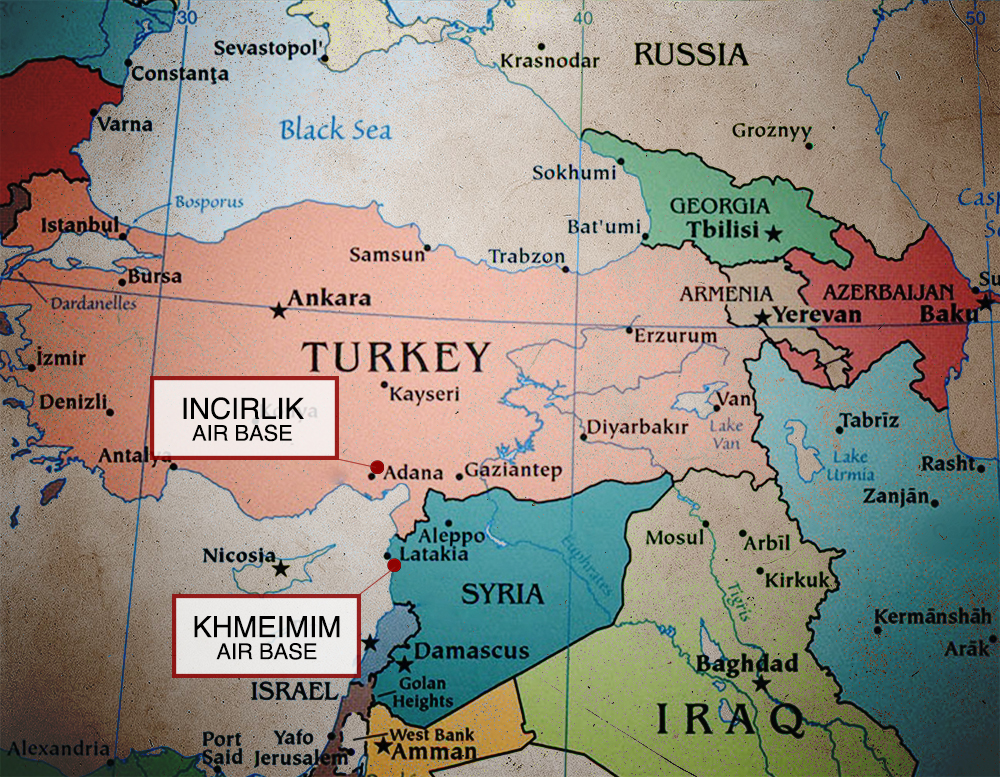

Saudi Arabia undoubtedly has one of the most modern and well-equipped air forces in the region and has invested heavily in this military tool for over two decades. The Royal Saudi Air Force (RSAF) gained a great deal of experience during the first gulf war, with its ground attack aircraft, primarily the Tornado, carrying out bombing missions. In addition, in some of the few air-to-air engagements of that conflict, Saudi pilots shot down Iraqi aircraft that were most likely fleeing to Iran.
The RSAF has been engaged in a bombing campaign against Houthi rebels in Western Yemen for many months now. Saudi Arabia decided upon direct military intervention to reinstall the Saudi aligned Abd Rabbuh Mansur Hadi after he was forced to flee the country by a popular uprising in Yemen. Fearing that an Iranian friendly government was coming to power in Yemen, Saudi Arabia decided to intervene and commenced a punishing, and arguably indiscriminant bombing of the Middle East’s poorest nation. The toll on the civilian population has been high, either exhibiting Saudi indifference or poor tactical execution of air power, or quite possibly both.
Little has been revealed regarding specific RSAF deployments to Turkey after Brigadier General Ahmed al-Asiri’s announcement of February 14th; however, it is most likely that Saudi Arabia has dispatched strike fighters and or bombers to Incirlik air base in Turkey. The only evidence that has been publicly released is of F-15S or F-15C strike fighters landing at Incirlik. These aircraft will be accompanied by their ground crews and necessary logistics support, who will arrive aboard follow on air transport.

Saudi Arabia has an impressive inventory of strike aircraft in use with various squadrons based across the kingdom. A mix of both U.S. and European aircraft are in use in these squadrons, from the venerable F-15C and Tornado, to the relatively new Typhoon. The F-15Cs and Tornados have all recently been modernized and 48 units of the Typhoon have been delivered to the Kingdom from Britain. As recently as 2013, the RSAF and British Royal Airforce (RAF) engaged in extensive joint training operations over the British Isles in Operation Green Flag. The training encompassed flights of 2 to 4 aircraft, both Tornados and Typhoons of the respective nations engaged in various aerial training operations including tactical formation flying, aerial patrol, air to air combat and interdiction, as well as ground attack. It is important to note that all flights were conducted with a mix of Saudi and British aircraft. This was done in order to bring Saudi aircrews up to speed on a new aircraft with pilots with a higher degree of time and proficiency with the Typhoon, as well as to enhance the Saudi-British ability at cooperative operations in case future developments in the Middle East would soon call these long-term allies together once again in joint operations.
F-15C/D Air Superiority Fighter
The RSAF has 70 F-15C single seat air superiority fighters as well as 16 F-15D twin seat air superiority fighter/trainers. The F-15C is a proven fighter aircraft of venerable service to many air forces of the world. It was purpose designed as an air superiority fighter in the 1970s and is still the mainstay of the USAF, having undergone numerous upgrades and modernization programs.

RSAF F-15C landing at an airbase in Saudi Arabia.
F-15S (E) Strike Fighter
The F-15S is the Saudi version of the F-15E Strike Eagle strike fighter. The RSAF has 70 x F-15S strike fighters in service. It is planned to upgrade all of these units to the latest F-15SA standard. Developed in the late 1980s as a strike version of the proven air superiority fighter, the F-15E can carry out both air superiority missions as well as ground attack missions. It has been used in U.S. military combat operations in Afghanistan, Iraq, and Libya and is currently engaged in ground attack missions over Iraq and Syria targeting ISIS.

A bomb laden F-15S taking off for a mission in Yemen.
Panavia Tornado IDS Strike Bomber
The Tornado was developed by the United Kingdom, Germany, Italy and the Netherlands in the 1970s to be a high performance strike bomber that could successfully engage Soviet infantry and armor on a hypothetical European battlefield. Saudi Arabia decided to purchase 48 x Tornado IDS aircraft in the late 1980s. The RSAF would eventually take purchase of both the IDS and ADV versions of the aircraft from the UK. It is phasing out the ADVs, but has signed a contract with BAE Systems to upgrade its total fleet of 84 x Tornado IDS aircraft at the cost of $4.6 billion (USD). The Tornado has proven rugged and reliable in service with a number of nations, and its variable swept wing design allows for high performance at low altitude, which is a major advantage in close air-support missions.
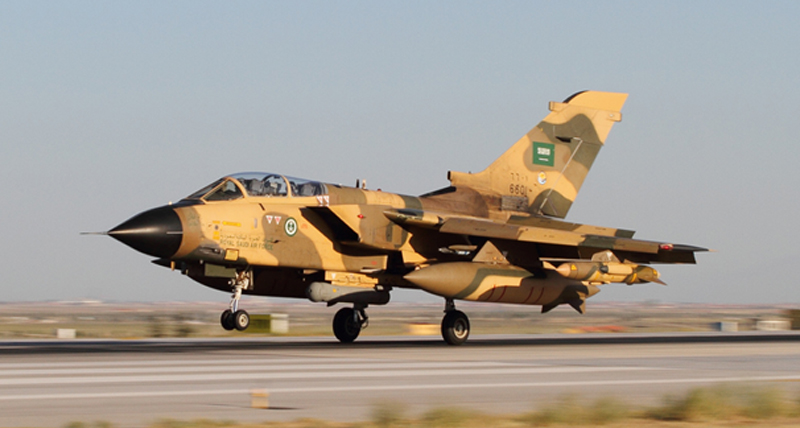
RSAF Tornado in desert colors, most likely of a squadron based at King Abdullah Aziz Air Base.
Eurofighter Typhoon
The Saudi Air Force has ordered a total of 72 Typhoon T-2 and T3A variants from BAE of the UK. Currently, one squadron, the 3rd Squadron of the RSAF 2nd Wing based at King Fahd airbase in northwestern Saudi Arabia is equipped with the Typhoon, with the 10th Squadron being established and equipped with these aircraft as well. Although this is a modern fighter with strike capabilities, it is rather unproven in combat compared to the F-15s and Tornados historically operated by the Saudis.
Considering that Saudi Arabia has decided to commit significant funds to the upgrading of its F-15S and Tornado IDS aircraft, it is a great wonder why they would decide to incorporate a totally new aircraft into RSAF ranks. The answer may have more to do with politics than military considerations. The Saudis have bought political influence and diplomatic favors by purchasing significant amounts of military hardware from the United States and Britain for many decades, and the Typhoon acquisition is likely just such a political investment.
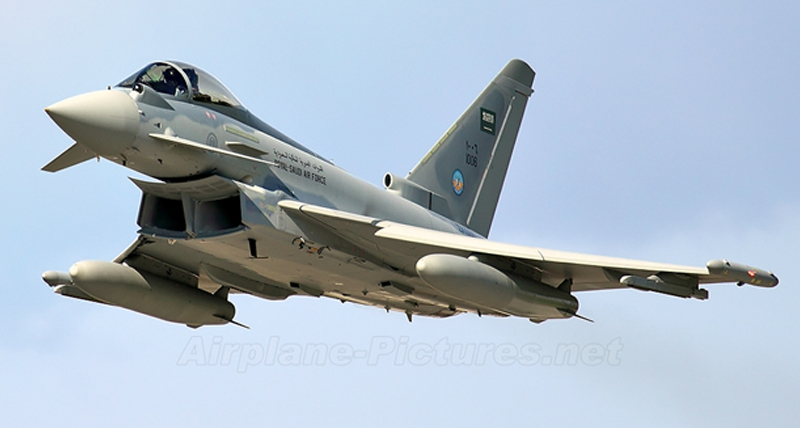
Typhoon T2 of the RSAF 10th Squadron. The 10th Squadron is being equipped with T2 and T3As currently.

With the RSAF engaged in bombing and reconnaissance missions over Yemen, fighters and strike fighters which are most likely based in the south of the kingdom at Dhahran (King Abdullah Aziz Air Base), may have to be pulled from this effort and forward deployed at Incirlik. There are a number of units based at the major air bases operated by the RSAF that could be repositioned.
Dhahran (King Abdullah Aziz) Air Base
- RSAF 3rd Wing
- 13 Squadron F-15C
- 92 Squadron F-15S (Saudi version F-15E Strike Eagle)
- RSAF 11 Wing
- 7th Squadron Tornado IDS
- 75th Squadron Tornado IDS
- 83rd Squadron Tornado IDS
Khamis Mushayt (King Khalid) Air Base
- RSAF 5th Wing
- 6th Squadron F-15S
Tabuk (King Faisal) Air Base
- RSAF 7th Wing
- 2nd Squadron F-15 C
Taif (King Fahd) Air Base
- RSAF 2nd Wing
- 3rd Squadron Typhoon F2/T3
- 5th Squadron F-15C
- 10th Squadron Typhoon F2/T3
- 34th Squadron F-15C
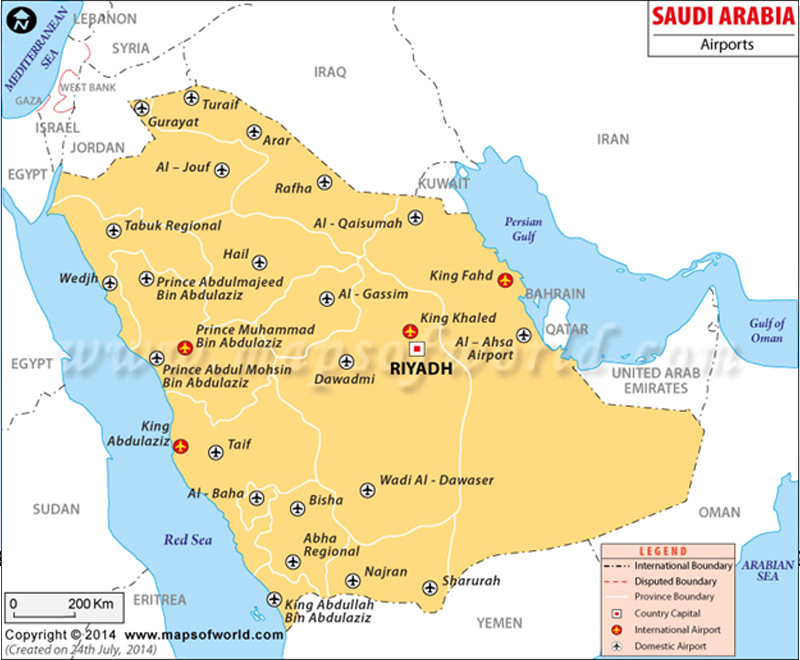
Major Saudi airports and air bases.

If Saudi Arabia is actually intent upon deploying and using a mix of strike aircraft and fighter escorts in Syria, they will most likely be based at Incirlik airbase, along with U.S. and other NATO air forces. This air base has the infrastructure and logistics in place to handle the aircraft of various NATO types and has been host to international forces in the past. The base is also close to the proposed area of operations (Northern Syria) and is guarded by modern air defenses, and even houses tactical nuclear weapons. With a regular USAF presence, this air base would be a very provocative target for attack by the Russian Air Force.
We are likely to see a small deployment of elements of two to four RSAF squadrons equipped with F-15C, Tornado, and Typhoon strike aircraft with possibly elements of one squadron of air superiority fighters in support. It is unlikely that the Saudis will make a major commitment, in line with their previous military commitments in the region as well as their ongoing quagmire in Yemen, which is occupying the attention of most of the strike aircraft squadrons based at King Abdullah Aziz Air Base in the southern portion of the kingdom.
Any Saudi force would most likely only go into battle with the backing of a U.S. or NATO mandate, and the employment of U.S. and NATO aircraft in preliminary strikes. It remains to be seen if the United States and NATO will take the bait and engage in a disastrous gambit to support their erstwhile NATO partner Turkey and the even more delusional Saudi monarchy. It is very clear that any air campaign engaged upon by Turkey and Saudi Arabia alone will be met with a swift and effective Russian response with both ground and naval-based air defenses as well as the most modern and capable air superiority fighters in the region. The Su-30 and Su-35 fighters are far superior to the Tornado, are more than a match for the F-15C and E and even the Typhoon. The Su-35 is the most modern Flanker variant in service in the world, and is more advanced in all respects to the Eurofighter Typhoon. The greatest difference, of course will be the pilot in the cockpit. Russian pilots have already exhibited their bravery, skill and professionalism since the Russian air campaign began at the end of September 2015. They have already accomplished more than Western estimates ever predicted, and in just about every respect. Russian pilots have proven that their exhaustive training in all matters of modern aerial combat have borne fruit, much to the delight of their supporters and allies and the chagrin and awe of their detractors.
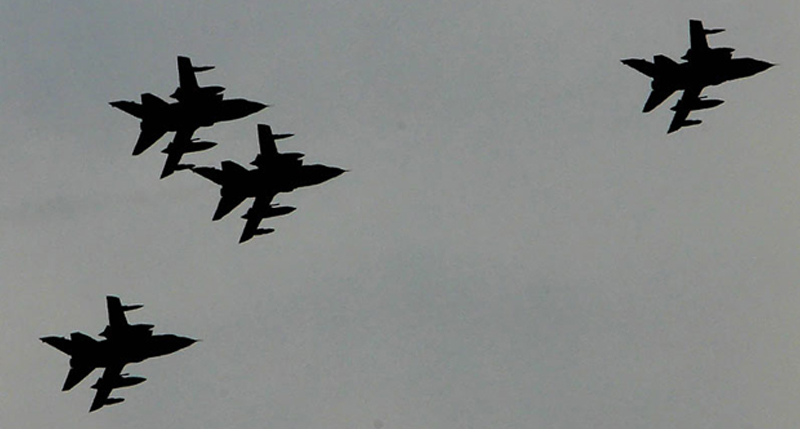
Saudi Tornados in formation.

Reports have circulated in the past six months that there is an internal power struggle within the higher leadership of the Saudi royal family, that King Salam is suffering from dementia, and that his younger son Deputy Crown Prince and Minister of Defense Mohammad bin Salam Al Saud, is vying with his older brother to assume the throne. Crown Prince Mohammed bin Nayef is the historically legitimate heir to the throne, being the eldest son. The Deputy Crown Prince is the recognized architect of the disastrous military campaign in Yemen. This campaign has brought to light the various shortcomings and ineptitude of the Saudi military in all aspects of modern warfare, most importantly command and control.
In Yemen, Saudi Arabia has grappled with the poorest and most poorly equipped army in the region and come up wanting. The Houthis have taken advantage of the poor coordination between Saudi Army units and their local allies and coalition partners on the ground. Saudi air raids have proven to be highly inaccurate and ineffective, regardless of the wealth of battlefield intelligence provided by U.S. spy satellites and surveillance aircraft. The Houthis have proven resilient and able to adapt quickly on the urban, desert and mountain battlefield, where their Saudi opponents have proven unable to make sound tactical decisions regarding the most basic of tactical issues. Much of these failures on the battlefield can be attributed to three main factors.
Firstly, the Saudis have no moral motivation. The Houthis and their allies are fighting a foreign invasion that hopes to re-impose, through force of arms, a tyranny that they themselves fought long and hard to rid themselves of over previous years. They are also defending their homeland, their friends and their families. What is the average Saudi soldier fighting for? They are fighting to impose the will of an unelected, theocratic monarchy on a nation of people who pose no military threat to them and that are willing to die to oppose them.
Secondly, the Saudi military suffers from long engrained cultural inhibitions that render proper decision making in a modern army impossible. NCOs and junior officers will not make decisions on the spot that are contrary to the exact orders given to them by their superiors as the realities of a battle unfold. Freedom of action, and the ability to make sound and timely decisions as the ever-changing factors on the battlefield change, is an imperative ability of NCOs and officers in combat. Equally important is the readiness of superior officers to share information with subordinates so that they are “in the loop” on the overall plan and changing developments in strategy and the goals of an operation. Saudi officers have been culturally programmed to keep information to themselves and to not trust nor give authority to subordinates “beneath” them.
Thirdly, the structure of the Saudi Army and the Saudi National Guard have been designed to ensure mistrust, a division within the leadership as well as the dissolution of military power between both organizations. This has been devised intentionally, so as to remove any threat that the military might pose to the Royal House of Saud. The Royal family wanted to ensure that no Gadhafi or Nasser would rise up through the officer ranks to depose them. This has resulted also in a noticeable division and mistrust between the Army, which falls under the direction of the Ministry of Defense, and the National Guard, which takes its orders from the Interior Ministry. To further solidify the division, military training, roles and equipment is divided amongst the two forces in a way that both are lacking elements that would allow them to be considered a self-sufficient, combined arms force. In order to prevail in combat, they would have to rely on one another fighting jointly; however, the system exists to ensure that they may never do so. In many respects, Saudi Arabia has the largest and best equipped Army in the Middle East that may never be used, as this would immediately reveal that it is simply a mirage.

It is obvious to anyone with even the most rudimentary understanding of the Syrian conflict, that neither Turkey nor Saudi Arabia has any intention of defeating ISIS or any of their Wahhabi affiliates in Syria. On the contrary, they aim to hinder the advance of the SSA and their allied forces and to degrade their offensive capability through direct military means now that their proxies have largely been defeated in a succession of military actions with the support of the Russian armed forces. Turkey has the added aim of making sure that a strong united Kurdish region is not allowed to solidify along its southern border.
The Erdogan regime has staked its future on toppling al-Assad and dividing Syria amongst the victors to its own benefit. It hopes to crush the aspirations of the Kurds and to eliminate the threat of an independent Kurdistan that would shake the very foundations of modern Turkey. Erdogan’s gamble is unraveling in front of his eyes, and the move to direct military intervention is an obvious sign of its failure. Erdogan’s foreign policy of destabilization in Syria have in fact only strengthened the Kurdish position and led to greater Kurdish autonomy.
Saudi Arabia on the other hand could care less about the Kurds. They have been more than happy to allow the “Kurdish dilemma “to occupy their neighbors to their own detriment. Saudi Arabia has invested a great deal of capital and resources in the establishment of a multitude of Wahhabi terrorist groups and mercenary armies that fight on its behalf, their great benefactor in ensuring the downfall of a secular Syria and the elimination of that state as a competitor in the production and transport of oil and natural gas out of the Middle East and into Europe. They hope to eliminate what was becoming a largely Shia dominated logistics pathway through Syria-Iraq-Iran, that stood to greatly undercut their position as a global giant in oil and natural gas production and transportation.
Saudi Arabia’s threat of direct military intervention in Syria also signals the failure of their war by proxy. Their armed gangs of Islamic zealots and terrorists have largely collapsed as a viable threat on the battlefield and face a certain defeat. Most of the moderate opposition was never embraced or aided by the Saudis, with such groups being either absorbed by the Islamist radicals, eliminated, or in time joining forces with the Syrian government. A failure in Syria along with a stalemate in Yemen may prove to be one failure too many for a Saudi monarchy that is suffering from internal division amongst itself and the hundreds of clans whose loyalty ensures their legitimacy. Failure in Syria may be the straw that breaks the camel’s back.

Russia has made it extremely clear, in diplomatic yet unambiguous terms that it will not allow any outside forces to invade Syria to topple the government and secure their own aims in violation of Syrian sovereignty. Prime Minister Dimitri Medvedev clearly stated to the world that Russia will not stand idly by while Turkey or Saudi Arabia invade the sovereign territory or airspace of Syria. Russia has not historically utilized its military outside of its borders, but when it does, it does not do so in half measures nor without a very clear idea of the goals and strategy for victory. It has invested a great deal in ensuring that Syria will become a stable country once again, a buffer between itself and the Middle East that will provide for the national security of Russia against the spread of state sponsored radical Islamism.
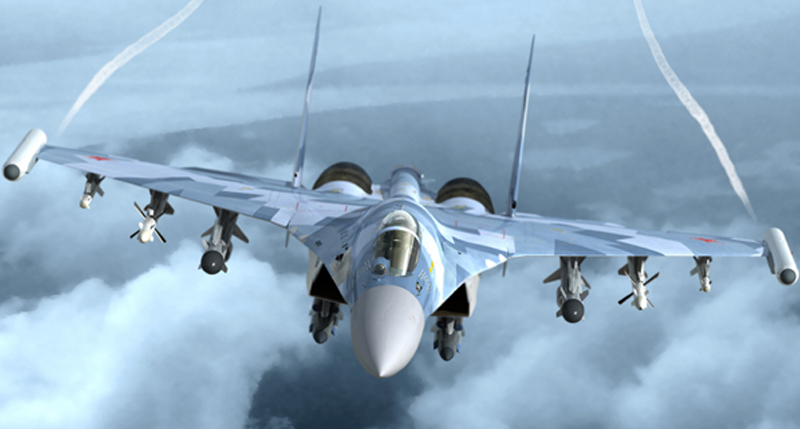
The latest generation Su-35. Its presence in Syria is a clear signal of Russia’s resolve.
Additionally, Russia has international law on its side in any dispute. It is carrying out military operations within Syria at the request of the legitimate government of that nation. It is honoring a long standing defense treaty with that same nation, and would continue to be doing so if outside parties violate Syrian sovereignty with hostile intent and Russia responds with force to repel such efforts. After Turkey downed a Su-27 bomber late last year, and their Turkmen proxies killed the pilot and a marine on a rescue mission to save the downed aircrew, the Russian leadership took very concrete steps to bolster air force and air defense capabilities in the Region. They sent a very clear message; this will not happen a second time.

The belligerent statements coming out of Riyadh over the past week coupled with the movement of RSAF combat aircraft to Incirlik air base in Turkey and the massing of ground forces of the Gulf Cooperation Council for joint training exercises on the Arabian Peninsula have brought the world to the brink of a war of global proportions. Instead of supporting efforts to bring about a ceasefire and de-escalation of violence in Syria, Turkey and Saudi Arabia have decided to work together to throw additional fuel on the fire. The Erdogan regime and the Saudi royal family are betting on U.S. and NATO support in their efforts; while at the same time expect Russia to abandon a long-term ally and their strategic interests in region.
It is quite possible that Turkey and Saudi Arabia will ignore the clear messages coming out of Moscow that Russia will not allow any military incursion on the part of these two parties, as well as the reality of the battlefield successes of the Syrian and Russian military efforts over the past four and a half months. With the failure and collapse of their proxies in the battle to oust al-Assad and forever tear apart Syria, the Turks and Saudis may have decided to double-down by directly involving themselves militarily. It remains to be seen whether this development is a bluff, or a major escalation of the war, which would trigger an immediate military response from Russia.
While the assets of the RSAF are modern and capable, they do not represent a technological or combat experience advantage over the forces that Russia can bring to bear in response. Russian air force and air defense forces present in Syria alone present a strong deterrent to any outside power seeking to violate the airspace of Syria without the expressed permission of the Syrian government. It is understood that any direct military confrontation between Saudi Arabia and Russia will further complicate and expand a costly regional conflict into a global one. Much of the world is currently holding its breath and hoping for sanity and pragmatism to carry the day and ease us back from the precipice of disaster.






I stand against Shia-genocide. The Sunni/Jewish alliance aims to wipe out all the Shia and Christians of the middle east. And Shia only make up 5% of Muslims, and they are the peaceful ones.